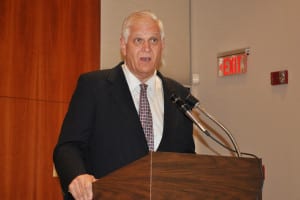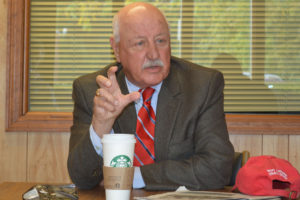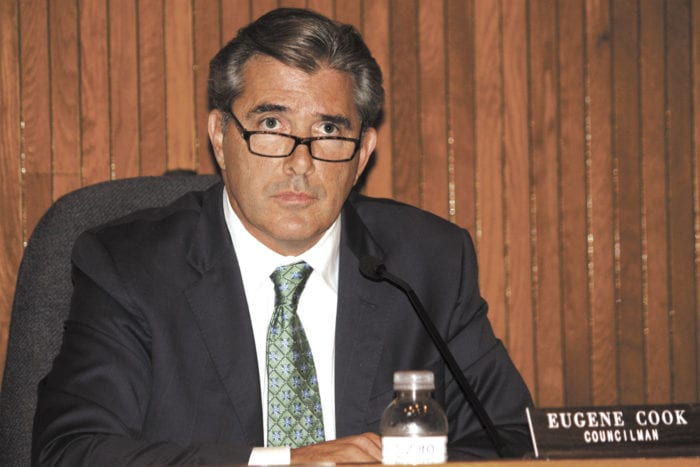After detecting something under the surface of the Rocky Point Fire Department in Shoreham using ground-penetrating radar, a duo of explorers asked permission to dig a 16-foot-deep hole on the property.
It was October 2017 and segments of a new Discovery Channel program “Tesla’s Death Ray: A Murder Declassified” were being filmed at the fire station, located just five minutes away from Wardenclyffe —
Nikola Tesla’s last standing laboratory.
With the go-ahead granted by Rocky Point Fire District Secretary Edwin Brooks, and then the rest of the district’s board, an excavation crew dug out the hole in hopes of finding the remnants of tunnels Tesla was rumored to have built under the grounds of his laboratory that connected to surrounding areas in the early 1900s.
Filming and research was also conducted on the property of the Tesla Science Center
at Wardenclyffe, but digging there was prohibited due to contamination on the site from previous tenants.

“We were definitely interested in what’s going on, and if there were some tunnels here, we’d like to know about it,” said Brooks, who was also interviewed for the show.
The multi-episode docuseries, which premiered Jan. 2 with new episodes every Tuesday, follows military investigator Jack Murphy and Tesla historian Cameron Prince on their quest to decode some of the mysteries and urban myths surrounding the Serbian-American inventor. The two aim to track down Tesla’s innovations and research that may have gone missing from his safe after he died in a hotel room in 1943 — including a supposed formula for a particle beam, or “death ray.” Murphy and Prince theorize that designing the fatal weapon could have caused someone to murder Tesla.
“I think that’s really far-fetched, and I don’t believe that’s the case — it’s all very speculative,” said Tesla Science Center President Jane Alcorn, who, along with other board members, allowed the crew to shoot on their premises last September. “But it’s been an interesting experience.”
Alcorn said the site receives many requests a year from film and television companies, as well as documentarians from all over. In addition to Discovery Channel’s show, the Science Channel also recently shot and aired a two-part episode for its “Secrets of the Underground” show with the subtitle “Tesla’s
Final Secrets,” which similarly tested the ground beneath the laboratory in search of clues for the death ray invention.
Before filming began, Alcorn said both companies had to fill out an application, which the Tesla Science Center board reviewed to ensure its shows met their requirements for science-based content. As the programs featured testing on the grounds using magnetometers and ground-penetrating radars, they were allowed to proceed.
“We can’t control what they do with their footage or what they find, but since they’re using this equipment, if they were to find anything, it was important that it is based on science and data,” Alcorn said. “Both shows were very cooperative and we had no problem with them. We had them on-site for a couple days — they would come in the morning, do their filming and testing, and then they would leave. They were also all excellent in terms of hiring good companies, with bonafide technicians that look for voids in the ground as a means to discover whether or not there’s something underground — not just for film projects but mining companies, too.”

As for Alcorn’s verdict of the shows themselves: Neither program led to any concrete discoveries, she noted, and both had the air of reality shows with repetitive material and cliffhangers before commercial breaks, which she “wasn’t crazy about.” But she said she and other board members are grateful that expensive testing was conducted and paid for by an outside company as they themselves had long been curious about what, if anything, was under the site’s surface. Now there’s a body of data that the board can examine if it wishes, she said.
“It was an opportunity for us to save some money and get some information,” Alcorn said.
Response to the shows has been mixed among residents. Some were happy to see Shoreham and its famous scientist represented, while others dismissed the shows as sensationalized and inaccurate.
“It’s great for people to learn who [Tesla] is and bring some knowledge of Wardenclyffe to the public so we can have it turned into a proper museum and erase some of the eyesore that is there,” Wading River resident Erich Kielburger said in a closed Shoreham-Wading River community group page on Facebook.
Amanda Celikors said her 7-year-old son watched the Discovery Channel show and was fascinated by it.
“He’s learned so much about Tesla and his impact on science,” she said. “We joked that the tunnels could lead to our house. I think it’s great.”
But Rob Firriolo was less than impressed.
“Typical reality TV trash,” he wrote on the Tesla Science Center at Wardenclyffe Facebook page. “Contrived and melodramatic, with annoying camera work and even more annoying music trying to gin up tension where there obviously is none. … We will get hours of fluff, hype and speculation with a payoff at the end as rewarding as Geraldo [Rivera] in Al Capone’s vault.”
Shoreham resident Nick Renna said in an interview he watched the Science Channel program, and enjoyed it as it shed some light on the historical value of the Wardenclyffe property.
“I thought it was really cool to see our own neighborhood on television,” Renna said. “Exposure is huge for that property. When most people hear Tesla, they think about the car, but in reality, without him, there would be no electricity, remote controls, radio waves — the guy was a historymaker. And that property is an incredible asset that we’re able to call home, to some degree.”
























